| کد مقاله | کد نشریه | سال انتشار | مقاله انگلیسی | نسخه تمام متن |
|---|---|---|---|---|
| 86119 | 159166 | 2015 | 12 صفحه PDF | دانلود رایگان |
• Pressure on tropical forests is significant despite better global forest management.
• More planted forests are necessary but insufficient for better forest management.
• Novel forest landscapes are important but elusive of global forest inventories.
• Planted-forest expansion significantly drives transitions to net forest gain.
The Global Forest Resources Assessment 2015 shows that deforestation has slowed and afforestation has increased globally during 1990–2015. Planted forests have increasingly provided goods and services hitherto derived from natural forests, and mosaic forests in agricultural landscapes are increasing. Forest gain is occurring at higher latitudes and in richer countries whilst forest loss continues in poor countries in the tropics. Some middle income tropical countries are now also transitioning to forest gain. These transition countries are characterised by reforms to forest management and improvements in agricultural practices but also by significant expansions of planted forest, which account for ∼25–100% of gains. Forest-area estimates of the FRA align with satellite-derived estimates, with deviations of ⩽±7% globally and ⩽±17% for the tropics. Mosaics comprised of trees outside forests, remnant forest patches, and young regenerating forests constitute a modest proportion of the tropical forest estate and are seemingly well inventoried by the FRA. Extensive areas of forest experienced partial canopy cover reduction since 2000, particularly in the tropics where their area is ∼6.5 times that deforested since 1990. The likelihood of the eventual loss of these forests and a decline in their capacity to provide goods and services is a matter of concern. Demand for industrial wood and fuelwood increased 35% in the tropics since 1990, principally in poorer countries, and growth in demand will accelerate into the future, particularly in the Asia-Pacific region. Notwithstanding significant increases in forests within protected areas since 1990 to 517 Mha (16.3%) globally and 379 Mha (26.6%) in the tropics, increasing demands for ecological services, forest products, and climate change mitigation is likely to be met from an expanding area of planted forests more than from the declining area of natural forests, particularly in Africa. The global rate of planted-forest expansion since 1990 is close to a target rate of 2.4% per annum necessary to replace wood supplied from natural forests in the medium term, though the expansion rate has declined to 1.5% since 2005. Multiple-use forests permitting both production and conservation account for 26% of the global forest area and 17% of the tropical forest area, and have increased by 81.8 Mha or 8.5% globally since 1990, with most gains in the tropics. Sustainable forest management in low-income and tropical countries remains modest, with only 37% low-income country forests covered by forest inventories. International support has proven effective at increasing this coverage since 2010.
Journal: Forest Ecology and Management - Volume 352, 7 September 2015, Pages 134–145
